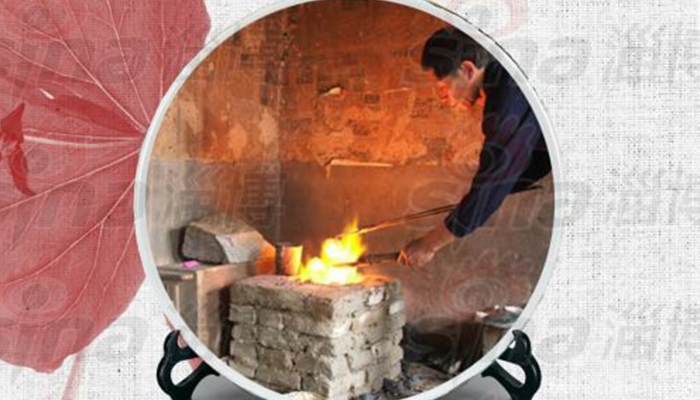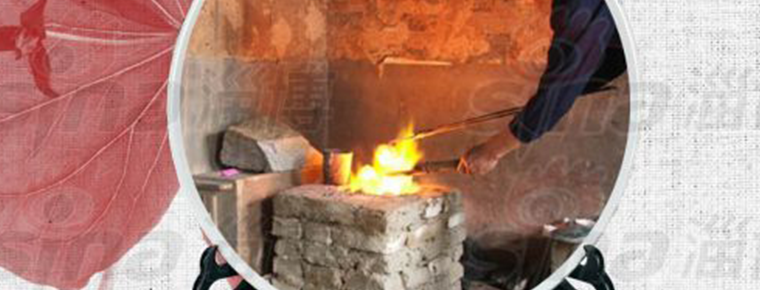Smelting Technology of Gold Chute Stone fill Stove
Smelting Technology of Gold Chute Stone-fill Stove
The smelting technique of gold chute rockfill stove was first seen in the history of Song Dynasty. Since the fourth year of Jingde in the Song Dynasty, Minister Pan Mei-lai adopted this method to supervise Linglong Gold Mine, the first official gold mine in China, this technique has been written into the History of Song Dynasty. After many dynasties, the inheritance has been flourishing, and its principle is still applied today. To this day, Zhaoyuan's goldsmiths who master this skill can trace their genealogy back to seven generations. The smelting technology of gold chute rockfill stove consists of four processes: crushing, grinding, drawing and smelting. Crushing: commonly known as sand breaking, ore should be crushed to the same size as peanuts. Grinding: Crushed ore should be milled after mixing with clean water evenly. The finer the sand grinding, the better, because it determines the level of ore dressing rate in the future.
In 2008, it was selected as the second batch of national intangible cultural heritage list.
Technical history
According to the burning remnants found in ancient pits in Zhaoyuan and the remains of gold mining by the ancestors such as charcoal, iron chisel, hammer, clay bowl and black pottery bowl, the original burnt-fired blasting method was used to extract gold in Zhaoyuan during the Spring and Autumn Period and the Warring States Period. The record of the smelting technique of the gold chute stone stove was first seen in the history of Song Dynasty, and Zhu Biao's Pingzhou Ketan Volume 2 of Song Dynasty recorded: "The metallurgy of the two states, taking sand along the stream and scouring it with wooden trays, is very little and laborious. Denglai gold pit households only use big wood, sawing it, leaving blade marks, throwing sand on it, flooding with water, sand, gold saw grain, very easy to get. This traditional technique of mining gold by hand-operated crushing, grinding, drawing and smelting with hammer, mortar, stone mill, stone mill, chute, Taozun (or crucible) and other advanced tools was later called "chute stove smelting method" by gold historians. In fact, it is the method of extracting gold by gravity beneficiation and high temperature smelting.
Craft procedure
Since the fourth year of Jingde in the Song Dynasty, Minister Pan Mei-lai adopted this method to supervise Linglong Gold Mine, the first official gold mine in China, this technique has been written into the History of Song Dynasty. . To this day, Zhaoyuan's goldsmiths who master this skill can trace their genealogy back to seven generations. The smelting technology of gold chute rockfill stove consists of four processes: crushing, grinding, drawing and smelting. Crushing: commonly known as sand breaking, the ore should be crushed to the same size as peanut rice. Grinding: Crushed ore should be milled after mixing with clean water evenly. The finer the sand grinding, the better, because it determines the level of ore dressing rate in the future. When pushing and grinding, people often sing while pushing in order to forget their hard work and reach the same pace. The simple song is not only full of gold miners'yearning for a better life, but also inherits the local folk culture. Beneficiation: commonly known as "pull flow". The concentrate, which is called gold mud, is selected mainly by gravity principle. This process has relatively high technical content and is relatively complex, and it is the key link of the whole process. When drawing, the ground ore powder is placed above the trough plate and evenly spread out to draw a ditch. When the water in the cylinder above the chute plate enters, the water flow should be controlled by gentle stroke or tapping with a uniform chop from left to right. This is the key to pulling flow, because the flow is large, it is easy to wash away the gold-bearing particles; the flow is small, but it can not wash away the slag, which can not meet the requirements of mineral processing. With the clear water flowing away, the stone slag leaves behind gold-bearing mineral particles, commonly known as "gold mud". After the pull-out, the gold mud is filled in a mud bowl, then dried with fire, and then the rabbit legs which can not adhere to the gold particles are used to clean the gold mud onto the paper, wrapped in paper bags and stored for refining. Smelting: commonly known as "chemical fire". When igniting, paper bags containing gold mud are put into crucibles which are determined to be free of cracks for smelting. After the gold mud is melted, the foam formed by impurities is continuously evaporated or extracted with iron pincers, and then the gold is purified by adding mirabilite and borax. When the molten gold is purified to a certain extent, it is poured into the gold mould, and the gold smelting is completed. The whole process is mastered by the experience and feeling of the goldsmith. The smelting technology of gold chute rockfill stove is not only inseparable from Zhaoyuan's gold mining history, but also occupies an important position in China's gold production history. It is this handicraft handicraft handicraft handicraft handed down from generation to generation that has laid a solid foundation for modern gold mining technology and promoted the development of gold industry.


-
1.Mount QianQianshan Mountain
Mount Qian,Qianshan Mountain is located 17 kilometers southeast of Anshan City, Liaoning Province, with a total area of 44 square kilometers.
Time 2018-12-04 -
2.Chen Yuns former residence and Qingpu Revolutionary History Memorial Hall
Chen Yun's former residence and the Qingpu Revolutionary History Memorial Hall are the only Memorial Hall in the country that systematically demonstrates Chen Yun's life achievements approved by the C
Time 2019-01-05 -
3.Hailing Island Dajiao Bay Sea Silk Road Tourist Area Yangjiang City
Dajiaowan Scenic Area of Hailing Island in Yangjiang is located in Zhapo Town of Hailing Island, Yangjiang City, Guangdong Province.
Time 2019-01-13 -
4.Eighteen Sayings on Tibetan Wedding Banquet
The Eighteenth Tibetan Wedding Banquet is a kind of folk oral literature spread in the Tibetan inhabited areas of the eastern agricultural region of Qinghai Province. Its manifestation is the eighteen
Time 2019-04-07 -
5.Major tune
The major tune was originally called "drum tune". Varieties of Quyiqu. It was first prevalent in Kaifeng, Henan Province, and then spread to Luoyang, Nanyang and other places.
Time 2019-04-23 -
6.Dai Medicine Sleeping Drug Therapy
Sleeping pill therapy, one of the ten traditional Dai medicine therapies, is the third batch of national cultural heritage in Yunnan.
Time 2019-04-24 -
7.Russian Basque Festival
"Russian Basque Festival" is an important traditional festival of the Russian people in Erguna, Inner Mongolia, no less than the Han Spring Festival. Every year during the period from late A
Time 2019-04-28 -
8.Legend of Mount Tai
Taishan legend is one of the folk legends in Shandong Province. According to legend, the history of the Theocracy of Taishan God in charge of life and death can be traced back to the pre-Qin period. A
Time 2019-06-18 -
9.Taishan Stone Dang Custom
Taishan Stone Dangdang Custom is a relic of ancient people's worship of spiritual stones. Mountain and stone are regarded as personality by myth, which is a typical traditional folk culture that has b
Time 2019-06-18 -
10.Beach Head Wood Engraving New Year Pictures
Tantou woodcut New Year's picture is the only handmade woodcut watermarking New Year's picture in Hunan Province. It has its own style with strong local characteristics in southern Chu. Tantou Town is
Time 2019-06-18 -
11.Neijiang scenic spot
Daqianyuan scenic spot is located in Yuanding mountain, Dongtong Road, Neijiang City, Sichuan Province. It integrates Zhang Daqian memorial hall, Zhang Daqian Museum, Zhang Daqian Art Museum, Zhang Daqian's former residence, Xilin temple, Lulan cave cliff tombs,
Time 2020-12-16 -
12.Nanchong hydrology
Nanchong is rich in precipitation. The average annual precipitation is 1000 mm, excluding evaporation, the annual total water is about 4.191 billion cubic meters, and the average annual runoff depth is about 313 mm. The distribution of runoff depth is generally
Time 2020-12-17